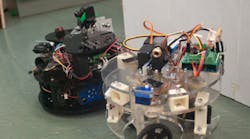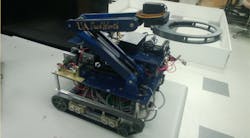It is April and it must be time to put out some fires. I am at annual Trinity College Fire Fighting Robot Contest in Hartford, CN. I am one of many technical speakers at this year's symposium. The last time I was up here was almost a decade ago. At that time, it was my daughter Laura, then a sophomore in high school, that was talking about her video object recognition system. She is now in Pittsburgh designing things like arms for robots.
In some ways, this year's competition is similar to what occurred many years ago. That is because there are new students trying to tackle similar challenges. The robots are a little more sophisticated but many of the same problems remain. For example, the competition area is not amenable to infrared sensors.
In any case, there are lots of robots here and even more areas of competition. The basic fire fighting robot contest has not changed a lot. The idea is to navigate a scale model, essentially a small maze, and locate the fire, a candle. The robot extinguishes the candle.
What has changed is the range of competitors. There are four divisions including a walking category. It is very impressive.
The competition has been expanded and now includes a robot waiter contest. There is a basic and and an advanced version but the idea is the same for both. The robot goes to a location, picks up a plate and delivers it to the table (Fig. 1). Like the fire fighting contest, it is a lot harder than it looks.
1. This is a robot waiter for the Trinity College Fire Fighting Compeition.
The advanced version of the contest is a bit more complex and so are the robots. The robot needs to recognize a tone to determine whether to bring the plate from one of two shelves in a simulated refrigerator. It must roll over an optical sensor to open the refrigerator door.
The top levels for both competitions are open to professionals as well as students so join in if you think you can do better. You will find good company here.

